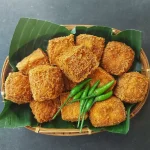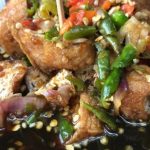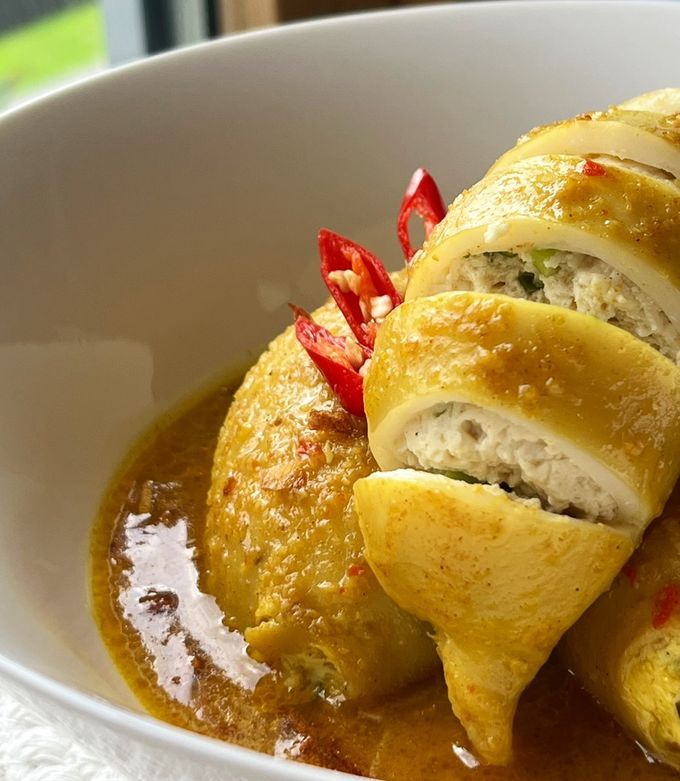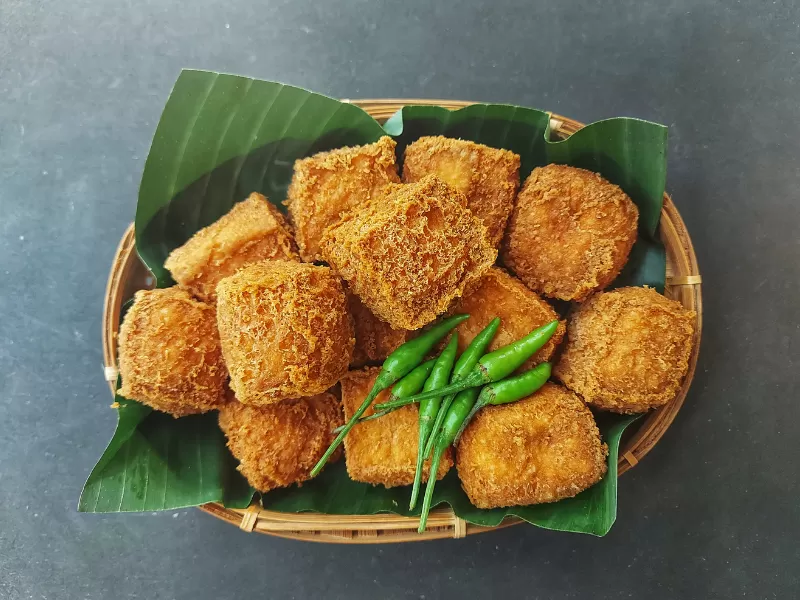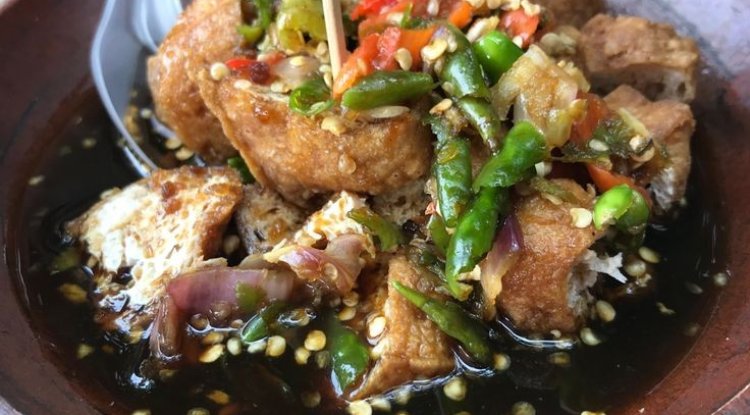Sotong Gulai Isi Tahu Telur is a beloved traditional Malaysian dish that exemplifies the rich tapestry of flavors and culinary techniques found across Malaysia’s diverse gastronomy. Combining tender squid, hearty tofu, and silky eggs in a fragrant and spicy coconut milk-based curry, this dish offers a harmonious blend of textures and tastes that appeal to many palates. Its origins are deeply rooted in Malaysian culture, where seafood and spices are integral to the local cuisine. Whether enjoyed during family gatherings, festivals, or everyday meals, Sotong Gulai Isi Tahu Telur remains a testament to Malaysian culinary artistry and the harmonious marriage of ingredients. This article explores the various facets of this dish—from its key ingredients to cooking methods, regional variations, and serving suggestions—providing a comprehensive overview of this flavorful delicacy.
Key Ingredients Used in Preparing Sotong Gulai with Tofu and Egg
The foundation of Sotong Gulai Isi Tahu Telur is built upon a selection of fresh, quality ingredients that come together to create a rich and aromatic curry. The main component, of course, is fresh squid (sotong), which should be firm, shiny, and free from any unpleasant odor to ensure optimal taste and texture. Tofu, preferably firm or medium-firm, adds a soft, creamy element to the dish, absorbing the flavors of the curry while providing a satisfying contrast to the squid. Eggs, usually hard-boiled or gently beaten and cooked into the curry, lend a silky texture and additional protein.
The curry base is typically flavored with a blend of spices and aromatics including shallots, garlic, ginger, and turmeric, which are ground into a paste to release their fragrant oils. Coconut milk is an essential ingredient, providing the rich, creamy sauce characteristic of gulai dishes. Tamarind paste or lime juice may be added to introduce a subtle tanginess, balancing the richness of the coconut milk. Other seasonings such as chili, galangal, lemongrass, and kaffir lime leaves add depth and complexity to the flavor profile.
Fresh herbs like cilantro and Vietnamese mint are often used as garnishes, enhancing the dish’s aroma and visual appeal. Some variations may include additional vegetables such as okra or eggplant to add more texture and nutrition. The choice of ingredients, especially the freshness of the squid and quality of the coconut milk, greatly influences the final taste, making these key components vital to achieving an authentic and delicious Sotong Gulai Isi Tahu Telur.
The seasoning balance is crucial; the dish should be neither too spicy nor bland, with a harmonious blend of savory, sour, and spicy notes. The quality and freshness of the ingredients are paramount, as they directly impact the overall flavor and texture of the curry. Thus, selecting good produce and spices forms the foundation for a successful preparation of this traditional Malaysian dish.
Step-by-Step Guide to Cooking Sotong Gulai Isi Tahu Telur
Begin by preparing the ingredients: clean and slice the fresh squid into rings or bite-sized pieces, peel and chop shallots, garlic, and ginger, and grind them with turmeric and other spices into a fragrant paste. In a pot, heat some oil and sauté the spice paste until it releases a strong aroma and turns slightly golden. This forms the flavorful base for the curry.
Next, add coconut milk to the pot, stirring gently to combine with the spice mixture. Bring the mixture to a gentle simmer, allowing the flavors to meld and the sauce to thicken slightly. At this stage, add tamarind paste or lime juice for acidity, along with salt, sugar, and chili to taste. Once the curry base is flavorful, introduce the squid into the pot, cooking until it turns opaque and tender—typically just a few minutes to prevent overcooking.
Meanwhile, prepare the tofu by cutting it into cubes and adding it to the curry, allowing it to absorb the surrounding flavors. For the eggs, hard-boil them separately, peel, and then cut them in half or quarters before adding them into the curry, or gently beat eggs into the curry to create a silky texture. Let everything simmer together briefly to allow the flavors to meld, being careful not to overcook the squid or tofu to maintain their textures.
Finally, garnish the dish with fresh herbs such as cilantro and serve hot. Accompany the Sotong Gulai Isi Tahu Telur with steamed rice or traditional Malaysian rice dishes like nasi lemak. The result is a rich, flavorful curry with tender seafood, soft tofu, and savory eggs, ready to be enjoyed with family and friends.
The Culinary Significance of Sotong in Malaysian Cuisine
Squid, or sotong, holds a prominent place in Malaysian cuisine, reflecting the country’s extensive coastline and rich marine resources. It is a versatile ingredient used in a variety of dishes ranging from stir-fries and satays to curries and soups. The popularity of sotong in Malaysian food culture underscores the importance of seafood in everyday diets, especially in coastal states such as Penang, Kelantan, and Sabah.
In traditional Malaysian cooking, sotong is appreciated not only for its delicate flavor but also for its ability to absorb spices and seasonings, making it ideal for curries like gulai. The texture of squid—tender yet slightly chewy—adds a satisfying element to dishes, balancing the softer ingredients like tofu and eggs. Its quick cooking time also makes it a convenient choice for preparing flavorful, hearty meals in a short period.
Sotong’s significance extends beyond its culinary versatility; it is also a symbol of local livelihood and cultural heritage. Many coastal communities depend on fishing as a primary source of income, and squid fishing is a vital part of their economy. As a result, dishes featuring sotong, such as Sotong Gulai, carry cultural pride and tradition, often passed down through generations.
Moreover, the incorporation of sotong into traditional recipes like gulai reflects Malaysia’s diverse culinary influences, including Malay, Indian, and Chinese cuisines. It exemplifies the harmonious blending of flavors and techniques that characterize Malaysian gastronomy, making sotong a cherished ingredient that connects communities through shared culinary heritage.
Nutritional Benefits of Tofu and Egg in Sotong Gulai
Adding tofu and eggs to Sotong Gulai not only enhances its flavor and texture but also boosts its nutritional profile, making it a wholesome meal. Tofu, derived from soybeans, is an excellent source of plant-based protein, which is essential for muscle growth, tissue repair, and overall health. It is also low in saturated fat and contains beneficial nutrients such as iron, calcium, magnesium, and antioxidants.
Eggs are a rich source of high-quality protein, containing all nine essential amino acids necessary for the body. They also provide vital nutrients like vitamin B12, vitamin D, choline, and selenium, which support brain health, immune function, and metabolic processes. The inclusion of eggs in the curry adds a silky texture and enhances the dish’s satiety, helping to keep you full and energized.
Together, tofu and eggs contribute to a balanced meal that offers a combination of protein, healthy fats, and essential micronutrients. This makes Sotong Gulai Isi Tahu Telur not only flavorful but also nourishing, suitable for a variety of dietary needs. It is especially beneficial for those seeking a nutritious, comforting dish that provides sustained energy.
Furthermore, the inclusion of these ingredients makes the dish more versatile for different dietary preferences. For vegetarians, tofu can serve as a primary protein source, while eggs provide additional nutritional value. Their presence in the curry also helps to offset the richness of the coconut milk, creating a well-rounded, healthful meal.
In summary, the nutritional benefits of tofu and eggs elevate Sotong Gulai from a flavorful delicacy to a nourishing, balanced dish that supports overall health and well-being, making it a popular choice among Malaysians and food lovers alike.
Flavor Profile and Aromatics of Sotong Gulai with Tofu and Egg
The flavor profile of Sotong Gulai Isi Tahu Telur is a delightful harmony of spicy, savory, and tangy notes, complemented by a rich, aromatic coconut milk base. The use of spices such as turmeric, chili, galangal, and lemongrass imparts warmth and depth, while the shallots, garlic, and ginger add pungency and sweetness. When cooked together, these ingredients develop a layered aroma that is both inviting and complex.
The coconut milk lends a creamy, slightly sweet undertone that balances the heat and spice from the chilies and spices, creating a smooth, luxurious texture. The addition of tamarind or lime juice introduces a subtle acidity that cuts through the richness, providing a refreshing contrast. Kaffir lime leaves and fresh herbs like cilantro and Vietnamese mint add citrusy and herbal notes, enhancing the dish’s fragrance and freshness.
The aromatics of the dish are further enriched by the sautéing process, which releases essential oils from the spices and herbs, creating a fragrant environment in the kitchen. The tender squid, tofu, and eggs absorb these flavors, resulting in a cohesive taste experience that is both comforting and invigorating. The overall flavor profile is dynamic, with a perfect balance of heat, sourness, umami, and sweetness.
The sensory appeal of Sotong Gulai Isi Tahu Telur lies in its aromatic complexity and the interplay of textures. The tender squid offers a slightly chewy bite, while the soft tofu and silky eggs provide contrast. The dish’s aroma alone can evoke feelings of warmth and satisfaction, making it a memorable culinary experience rooted in Malaysian tradition.
Variations of Sotong Gulai Isi Tahu Telur Across Different Regions
While the core ingredients and preparation methods of Sotong Gulai remain consistent, regional variations across Malaysia add unique local flavors and touches. In the northern states like Penang and Kedah, the dish often features a more intense use of spices and chili, resulting in a spicier, more robust flavor profile. The use of local herbs and ingredients, such as turmeric and lemongrass, may be more pronounced to reflect regional tastes

